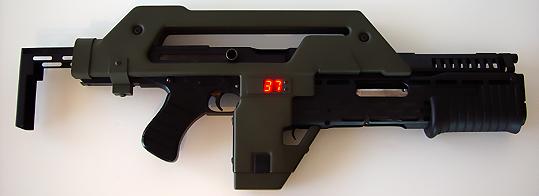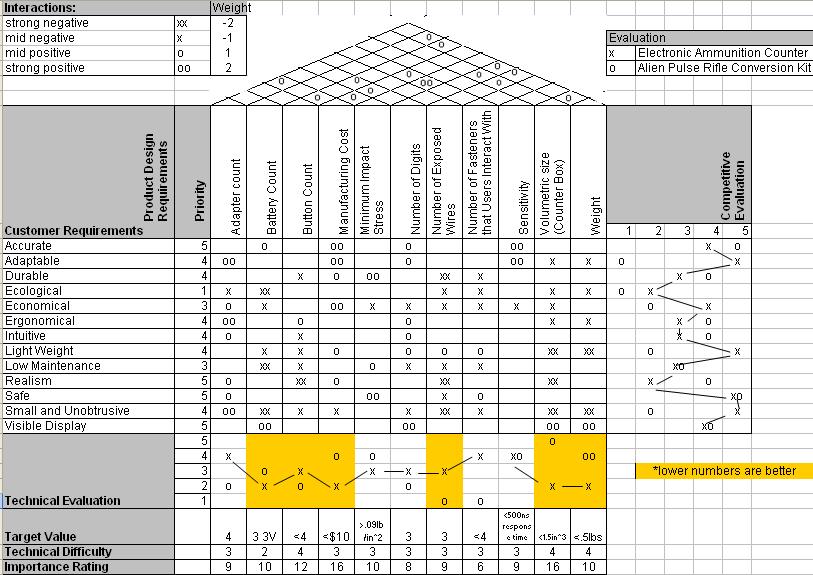Airsoft Electronic Ammunition Counter Final Report
From DDL Wiki
m (→A Little Bit About the Design Team) |
(→Airsoft Background) |
||
| Line 4: | Line 4: | ||
= Airsoft Background = | = Airsoft Background = | ||
Airsoft is a combat sport very much like paintball. The objective of the game is to eliminate other players by hitting opponents with plastic pellets fired from their airsoft guns. The guns used in airsoft games are replicas of real world guns both in a gun's shape and weight, although most airsoft guns are made of plastic rather than metal like their real world counterparts. Like real guns, airsoft guns fire their ammunition by expelling high pressure gas out the barrel. How this high pressure is created is how the gun is classified. <i>Automatic electric guns</i> (AEGs for short) dynamically create high pressure gas through a motorized spring piston system, while as <i>gas guns</i> simply releases gas stored at high pressure. The ammunition fired from airsoft guns are spherical plastic pellets that have a 6mm diameter and usually weigh anywhere from .20-.25g. These pellets have muzzle velocities between 175-500ft/s which makes them capable of hitting targets over 200ft away. | Airsoft is a combat sport very much like paintball. The objective of the game is to eliminate other players by hitting opponents with plastic pellets fired from their airsoft guns. The guns used in airsoft games are replicas of real world guns both in a gun's shape and weight, although most airsoft guns are made of plastic rather than metal like their real world counterparts. Like real guns, airsoft guns fire their ammunition by expelling high pressure gas out the barrel. How this high pressure is created is how the gun is classified. <i>Automatic electric guns</i> (AEGs for short) dynamically create high pressure gas through a motorized spring piston system, while as <i>gas guns</i> simply releases gas stored at high pressure. The ammunition fired from airsoft guns are spherical plastic pellets that have a 6mm diameter and usually weigh anywhere from .20-.25g. These pellets have muzzle velocities between 175-500ft/s which makes them capable of hitting targets over 200ft away. | ||
| - | |||
| - | |||
| - | |||
| - | |||
| - | |||
Airsoft began in Japan in the early 1980s out of necessity. At the time, there was a small market of Japanese sporting enthusiasts who wanted to own guns but could not do so because Japanese law forbids it. Consequently, the Japanese did the next best thing by creating airsoft guns. Airsoft guns allowed the Japanese to come as close as they possibly could to imitating real guns. The realism of airsoft guns is one of the appeals of airsoft. | Airsoft began in Japan in the early 1980s out of necessity. At the time, there was a small market of Japanese sporting enthusiasts who wanted to own guns but could not do so because Japanese law forbids it. Consequently, the Japanese did the next best thing by creating airsoft guns. Airsoft guns allowed the Japanese to come as close as they possibly could to imitating real guns. The realism of airsoft guns is one of the appeals of airsoft. | ||
Revision as of 00:11, 10 December 2007
Contents |
Executive Summary
We did stuff and it worked nicely
Airsoft Background
Airsoft is a combat sport very much like paintball. The objective of the game is to eliminate other players by hitting opponents with plastic pellets fired from their airsoft guns. The guns used in airsoft games are replicas of real world guns both in a gun's shape and weight, although most airsoft guns are made of plastic rather than metal like their real world counterparts. Like real guns, airsoft guns fire their ammunition by expelling high pressure gas out the barrel. How this high pressure is created is how the gun is classified. Automatic electric guns (AEGs for short) dynamically create high pressure gas through a motorized spring piston system, while as gas guns simply releases gas stored at high pressure. The ammunition fired from airsoft guns are spherical plastic pellets that have a 6mm diameter and usually weigh anywhere from .20-.25g. These pellets have muzzle velocities between 175-500ft/s which makes them capable of hitting targets over 200ft away.
Airsoft began in Japan in the early 1980s out of necessity. At the time, there was a small market of Japanese sporting enthusiasts who wanted to own guns but could not do so because Japanese law forbids it. Consequently, the Japanese did the next best thing by creating airsoft guns. Airsoft guns allowed the Japanese to come as close as they possibly could to imitating real guns. The realism of airsoft guns is one of the appeals of airsoft. In fact, many airsoft games have been called "milsims" (short for "military simulations") since not only are players carrying realistic looking guns, but players often go to games wearing military fatigues as well as bringing two way radios and other military equipment. The appeal of airsoft's realism goes beyond civilian usage as certain police and military forces have been known to use airsoft guns for training exercises.

Source: http://www.wpairsoft.com/forum/
Opportunity
Ammunition is a fundamental need of an airsoft player. Without ammunition, players can neither eliminate opponents nor can they defend themselves from being eliminated by the opposing team. Airsoft players understand they should avoid running out of ammunition, but even the best of players has had a game in which they prematurely ran out of ammunition. [INSERT GENERIC STATEMENT ABOUT MARKET RESEARCH AND HOW OFTEN THIS IS A PROBLEM] The primary cause of this problem is that it is very difficult for airsoft players to say, with reasonable certainty, how ammunition they have remaining in their magazines. Some players shake their magazine and listen to the rattling sound made by the remaining pellets in order to get an idea of much ammunition is left in their magazine. This method is not very accurate and actually only works on certain kinds of magazines. The rest of the airsoft players simply guess their remaining ammunition count based on how many times they have fired their gun. This is also a poor way to gauge how much ammunition is left in a magazine.

Source: http://www.clayjohanson.com/html/M41-A(1).jpg
To date, there are not really any airsoft products that solves this problem. The only relevant airsoft product is the M41A Pulse Rifle Kit. This kit converts a Tokyo Marui M1A1 into a M41A replica. In keeping true to a M41A's functionality, the kit includes an LED display that shows a number representing how much ammunition is left in the magazine. This kit may sound like something airsoft players should embrace since the LED display solves the issue of not knowing how much ammunition is in the magazine. However, the reality of it is that this kit is worthless to the majority of airsoft players. The problem with this kit is that it is specifically designed to work only on a Tokyo Marui M1A1. What airsoft players really need is an LED ammunition counter that works on all guns. That is the opportunity we have chosen to pursue.
Design Solution
Overview
Our team has designed an electronic ammunition counter that allows airsoft players to know exactly how much ammunition is left in their magazines. The premise behind our counter is simple: when users want to know how much ammunition is in their magazine, they simply look at the number shown on our counter's LED display. This number represents the number of airsoft pellets currently in the magazine. Our counter is a very convenient product for airsoft games since it runs autonomously while the user fires their gun. The only action required on the user's part, outside of a one time installation and setup, is to hit the reset button when they reload their magazine.
How It Works
When an airsoft pellet is fired, it passes out of the gun's barrel and out through the flash hider. Hidden inside of the flash hider is a photogate sensor. Photogate sensors are electronic components that produce more or less voltage depending on whether or not something is between its two gates. As for our counter, the photogate sensor in the flash hider is used to detect when airsoft pellets have been fired from the gun. The flash hider has wires leading to the display box. When an airsoft pellet is fired, the display box receives a lesser voltage from the photogate sensor that when no pellet is fired. The electronics inside of the display box recognizes this drop in voltage as meaning that an airsoft pellet has been fired. Consequently,the counting circuit subtracts one from the current magazine ammunition count. The updated ammunition count is then shown on the display LED.
Engineering Drawings of Components with Assembly Process
Analysis
Numerical Calculations on Photogate Circuit
DFX/FMEA Analysis
Quality Function Deployment
Below is an product planning matrix that compares our design with the Alien Pulse Rifle Conversion Kit, a competing airsoft product with an LED ammunition counter.
From the product planning matrix, we can see that the volumetric size of the counter box and the manufacturing cost are shown to be very important to our final product design. A technical evaluation of our product shows that in both these areas the Electronic Ammunition Counter is superior to that of the Alien Pulse Rifle Conversion Kit. The Electronic Ammunition counter has a more simplistic design than the pulse rifle conversion kit, and as a result, the manufacturing cost of the Electronic Ammunition is significantly less than that of the Alien Pulse Rifle Conversion Kit.
From the competitive evaluation column, we see that we can improve the counter design by adding more realism. Although the Alien Pulse Rifle is not based on a realistic gun, it has a higher realism rating than our counter box as the Alien Pulse Rifle aims the mimic the gun from Aliens. Our ammunition counter on the other hand was meant to be placed on a military simulation gun. As a result, the counter should have been hidden in such a fashion that it resembles an accessory used for military simulations. This is one aspect of our ammunition counter that we should look into at a later time.
The product planning matrix also indicates that we can improve our design by reducing the of buttons that the user interacts with and the number of exposed wires. The competitor's product does not have any exposed wires or preset buttons as these features were integrated into the gun. The addition of exposed wires and preset button cause our counter to look less realistic and less ergonomical. Although our counter has poor ratings in these area when compared with the pulse rifle modification kit, it is a necessary evil as our electronic counter is more adaptable as a result of these trade offs. Our goal was to design an aftermarket product that can be used on nearly any airsoft gun, and to do this, a bit of convenience and realism has to be sacrificed. Whereas the Alien Pulse Rifle Conversion Kit targets players who want a gun based on a movie, the Electronic Ammunition Counter was designed for any airsoft player who wants to know the ammunition count in their magazines.
Possible ways to reduce the number of exposed wires though include adding a transmitter and receiver to the flash hider and counter. This is another area in which we can study at a further point in time.
The Prototype
write about how prototpye differs form final as well as explain how and why we made prototype.

